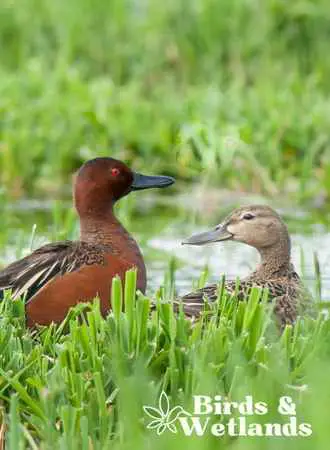Cinnamon teal (formerly Anas cyanoptera) is a dabbling duck found in the western regions of the Americas. It is named after the cinnamon-red color of its head and body. It feeds on aquatic plants and invertebrates by dabbling on the water surface or swimming forward with their heads submerged in the water.
Scientific Name: Spatula cyanoptera
Height: 21.3-22.4 in (54-57 cm)
Wingspan: 22-inch (560 mm)
Weight: 11.8-14.1 oz (335-401 g)
Cinnamon Teal Description
The cinnamon teal has five subspecies:
- Northern cinnamon teal (Spatula cyanoptera septentrionalium)
- Tropical cinnamon teal (Spatula cyanoptera tropica)
- Borrero’s cinnamon teal (Spatula cyanoptera borreroi)
- Andean cinnamon teal (Spatula cyanoptera orinoma)
- Argentine cinnamon teal (Spatula cyanoptera cyanoptera)

Appearance
The breeding male cinnamon teal is easily distinguished by its bright cinnamon head and body plumage. The dark rump, tail and undertail coverts contrast sharply, while the light blue patch with a white rear border on the upper wing is truly striking.
The iridescent green back wings are also notable, as is the large, black bill. Finally, the yellow legs, feet, and distinctive red eye complete the picture of this beautiful bird.
Female and non-breeding cinnamon teal share the same gray-brown plumage. They have a small white patch at the base of a long dark bill and a light blue patch with a white border on their wings.
Moreover, they have dark brown eyes and faint dark eyeliner and cap. They are slightly smaller than the male cinnamon teal.
Juveniles share the same plumage and appearance as an adult female cinnamon teal.
Listen to Cinnamon Teal
Cinnamons are beautiful ducks and vocal birds. Their calls can vary depending on the situation. Males give a sharp “kree” call during courtship displays, while females produce a softer “kree-eek” when soliciting food from the males. Both sexes make alarm calls and usually take the form of a loud “gak!” or “quack!”
Cinnamon Teal Habitat
The cinnamon teal is found in North and South American freshwater wetlands. Large, permanent marshes with abundant emergent vegetation are their preferred habitat. They must also be near shallow water and dense vegetation for cover.

Cinnamon Teal Geographic Range
The cinnamon teal breeds in the western parts of the Americas.
In western North America, they breed in British Columbia, eastern Montana, southern California, Arizona and Texas. These birds spend winters in southern part of its range which includes Mexico, the Caribbean and other parts of northern South America.
The two subspecies — Andean and Argentine cinnamons inhabit the wetlands in the Andes region of South America.
Cinnamon Teal Diet
Cinnamon teals are dabbling ducks that are native to the Americas. Like the northern shoveler and the green-winged teal, they have a varied diet consisting of plant materials such as aquatic plants, leaves, tubers, roots and grasses. Occasionally, they also feed on insects, worms, larvae, snails, mollusks, arthropods and other aquatic invertebrates.

Cinnamon Teal Behaviors
Cinnamon teals are not as gregarious as other species of ducks. Most of the time, pairs of cinnamon live alone. However, some cinnamons migrate from and to their breeding range in small flocks of 20 birds.
Cinnamon couples roost and sleep together, with the male remaining alert while the female sleeps. These ducks may sleep on water or land that is close to the water.
During the breeding season, females are protective of their nests and will attack any perceived threats away from the nest sites. In contrast, the males can be territorial but not quite as confrontational as the females. They rarely attack any intruders and instead circle the nest area.
These aquatic birds have a peculiar habit of following each other while taking advantage of food stirred up by the first bird.
Cinnamons are impressive fliers. They are agile while in the air and can make sudden turns when necessary. Furthermore, they have a good lift and strong wings that allow them to take off directly from the water.
Cinnamons may interbreed with their very close relatives — the blue-winged teal.
Cinnamon Teal Nesting & Mating Habits
These birds return to their breeding grounds during annual spring migration.
Males cinnamons are known for their elaborate courtship displays, which often involve repeated calls, head-turning and head-dipping. In the presence of several males, they may perform flight displays to attract their mate.
Once the female chooses her mate, the pair will swim toward each other while bobbing their heads. A copulation between the male and female may occur on land or water, with the male grabbing the female by the neck using its bill. After mating, the pair will swim and preen.
The female chooses the nest site, which is usually on the ground near the water with dense aquatic vegetation for cover.
She builds the nest in a shape of a half-moon. The nest, which is a shallow depression, is made with soft plant materials such as plant stems, dead grass and some down feathers plucked straight from the female’s breast.
The female lays 8 to 12 creamy-white eggs and incubates them for 21 to 25 days. Once all the eggs hatch, the ducklings will venture out of the nest. The young brood are capable of feeding their own food but will follow their mother when searching for food sources.
Young ducks will remain under the care of their mother until they are fully fledged at about seven weeks from hatching. They reach reproductive maturity at one year and will begin searching for a mate.

Cinnamon Teal Population & Conservation Status
The species is evaluated as Least Concern by the IUCN. However, the population is declining due to habitat loss, climate change, hunting pressure and predation by coyotes and domestic cats. Nonetheless, due to their relatively large range, cinnamons have yet to reach the threshold for Vulnerable status.
The current estimated population of cinnamons is 380,000.
Cinnamon Teal Hunting
Cinnamon teals are popular game birds that can be hunted and shot in many parts of the United States. There may be limits on the number of cinnamon teals that can be taken in a season in some states, so check the regulations before hunting.

Key Points
- The majority of cinnamon teal breed in the western parts of the Americas, including the western United States and the Andes region.
- The adult male has a cinnamon-red head and body, while the female has a pale-brown head and mottled brown body.
- The female has a grey bill, while the male has a dark bill.
- The male has red eyes, while the female has dark brown eyes.
- Cinnamons eat grasses, sedges, seeds, aquatic insects and small fish.

